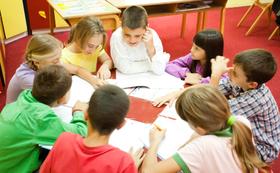Top Rankings
West Windsor-Plainsboro Regional School District ranks among the top 20% of public school district in New Jersey for:
Category
Attribute
Overall Rank
Highest overall rank (Top 10%)
Math Proficiency
Highest math proficiency (Top 10%)
Reading/Language Arts Proficiency
Highest reading/language arts proficiency (Top 10%)
Science Proficiency
Highest science proficiency (Top 5%)
Graduation Rate
Highest graduation rate (Top 5%)
Community Size
Largest student body (number of students) (Top 1%)
For the 2025-26 school year, there are 2 public preschools serving 1,165 students in West Windsor-Plainsboro Regional School District. This district's average pre testing ranking is 8/10, which is in the top 30% of public pre schools in New Jersey.
Public Preschools in West Windsor-Plainsboro Regional School District have an average math proficiency score of 67% (versus the New Jersey public pre school average of 36%), and reading proficiency score of 57% (versus the 44% statewide average).
Minority enrollment is 88% of the student body (majority Asian), which is more than the New Jersey public preschool average of 64% (majority Hispanic).
Overview
This School District
This State (NJ)
# Schools
10 Schools
923 Schools
# Students
8,943 Students
368,793 Students
# Teachers
781 Teachers
33,264 Teachers
Student-Teacher Ratio
11:1
11:1
Student By Grade
District Rank
West Windsor-Plainsboro Regional School District, which is ranked within the top 10% of all 645 school districts in New Jersey (based off of combined math and reading proficiency testing data) for the 2022-2023 school year.
The school district's graduation rate of 97% has decreased from 98% over five school years.
Overall District Rank
#55 out of 648 school districts
(Top 10%)
(Top 10%)
Math Test Scores (% Proficient)
68%
38%
Reading/Language Arts Test Scores (% Proficient)
77%
49%
Science Test Scores (% Proficient)
57%
23%
Graduation Rate
97%
85%
Students by Ethnicity:
Diversity Score
0.45
0.71
% American Indian
n/a
n/a
% Asian
73%
8%
% Hispanic
5%
36%
% Black
5%
16%
% White
13%
36%
% Hawaiian
n/a
n/a
% Two or more races
4%
4%
All Ethnic Groups
District Revenue and Spending
The revenue/student of $24,905 in this school district is less than the state median of $26,940. The school district revenue/student has stayed relatively flat over four school years.
The school district's spending/student of $32,439 is higher than the state median of $25,837. The school district spending/student has stayed relatively flat over four school years.
Total Revenue
$223 MM
$36,642 MM
Spending
$290 MM
$35,142 MM
Revenue / Student
$24,905
$26,940
Spending / Student
$32,439
$25,837
Best West Windsor-Plainsboro Regional School District Public Preschools (2025-26)
School
(Math and Reading Proficiency)
(Math and Reading Proficiency)
Location
Quick Facts
Rank: #11.
Town Center Elementary School At Plainsboro
(Math: 75-79% | Reading: 70-74% )
Rank:
Rank:
10/
Top 10%10
700 Wyndhurst Drive
Plainsboro, NJ 08536
(609) 716-8330
Plainsboro, NJ 08536
(609) 716-8330
Gr: PK-3 | 438 students Student-teacher ratio: 8:1 Minority enrollment: 94%
Rank: #22.
Maurice Hawk Elementary School
(Math: 65-69% | Reading: 55-59%)
Rank:
Rank:
8/
Top 30%10
303 305 Clarksville Road
Princeton Junction, NJ 08550
(609) 716-5425
Princeton Junction, NJ 08550
(609) 716-5425
Gr: PK-3 | 727 students Student-teacher ratio: 12:1 Minority enrollment: 84%
Recent Articles

Charter Schools vs Public Schools 2025: Key Differences & Trends
Explore updated 2025 insights comparing charter schools vs public schools, enrollment, academic outcomes, funding, and real-world examples for families and educators.

Are Public Schools Ready for the 21st Century? 2025 Update
Explore 2025 insights on whether public schools are ready for the 21st century, covering performance, technology, equity, funding, and future-ready learning.

Public School Open House & Enrollment Season Guide
A parent-focused guide to the public school open house and enrollment season, with expert questions, timelines, and decision tips.





